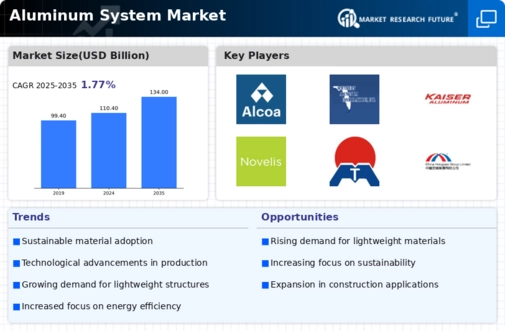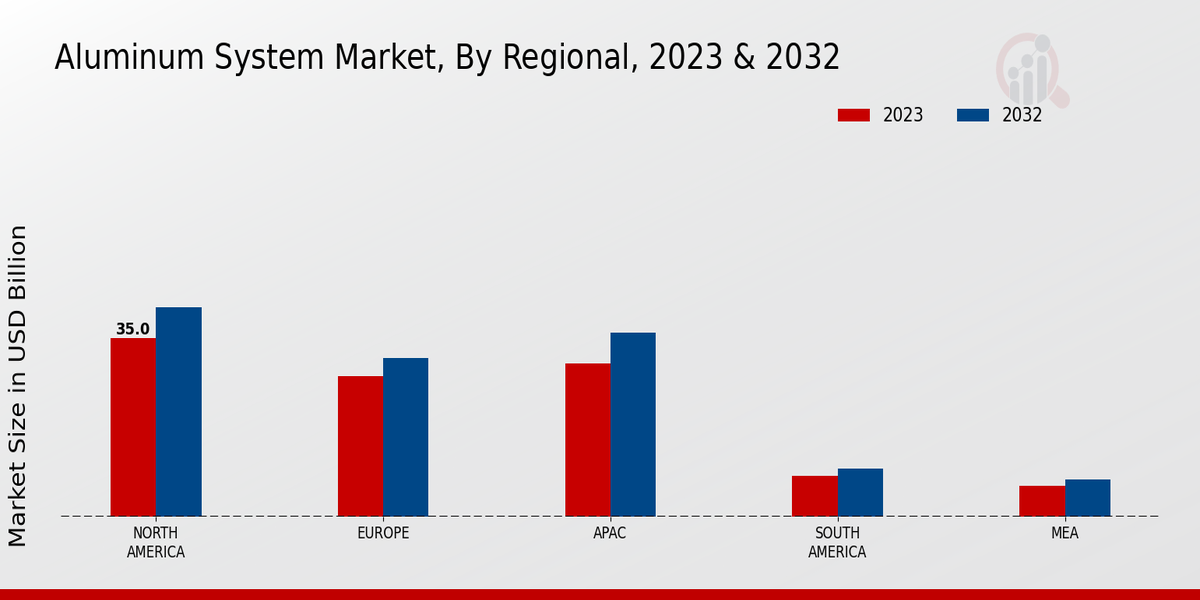Market Trends and Projections
The Global Aluminum System Market Industry is characterized by various trends and projections that indicate its future trajectory. In 2024, the market is valued at 110.4 USD Billion, with expectations to reach 134.0 USD Billion by 2035. The compound annual growth rate from 2025 to 2035 is projected at 1.77%. These figures suggest a steady growth pattern, influenced by factors such as technological advancements, sustainability initiatives, and increasing demand across various sectors. The market's resilience and adaptability to changing consumer preferences further underscore its potential for continued expansion.
Sustainable Construction Practices
The Global Aluminum System Market Industry is increasingly influenced by the rising demand for sustainable construction practices. Aluminum, known for its recyclability and lightweight properties, aligns well with eco-friendly building initiatives. As governments worldwide implement stricter regulations on carbon emissions, the construction sector is shifting towards materials that minimize environmental impact. For instance, aluminum's lifecycle analysis shows a lower carbon footprint compared to traditional materials. This trend is expected to drive the market, as the industry is projected to reach 110.4 USD Billion in 2024, reflecting a growing preference for sustainable solutions.
Growing Demand in Automotive Sector
The automotive sector's increasing demand for lightweight materials is a key driver for the Global Aluminum System Market Industry. Aluminum's favorable strength-to-weight ratio makes it an ideal choice for manufacturers aiming to enhance fuel efficiency and reduce emissions. Major automotive companies are incorporating aluminum components in their vehicles to meet regulatory standards and consumer preferences for greener options. This trend is evidenced by the rise in aluminum usage in electric vehicles, which is expected to continue growing. Consequently, the market is anticipated to expand, with a compound annual growth rate of 1.77% projected from 2025 to 2035.
Increased Focus on Energy Efficiency
The Global Aluminum System Market Industry is witnessing a heightened focus on energy efficiency in building designs. Aluminum systems are increasingly utilized in energy-efficient windows, doors, and facades, contributing to reduced energy consumption in buildings. Regulatory frameworks promoting energy efficiency standards are encouraging architects and builders to adopt aluminum solutions. For instance, the integration of thermal breaks in aluminum frames enhances insulation properties, leading to lower heating and cooling costs. This growing emphasis on energy efficiency is expected to drive market growth, aligning with global sustainability goals.
Urbanization and Infrastructure Development
Rapid urbanization and infrastructure development are pivotal factors propelling the Global Aluminum System Market Industry. As urban populations grow, the demand for residential and commercial buildings increases, necessitating efficient and durable construction materials. Aluminum's versatility allows for a wide range of applications, from facades to structural components. Governments are investing heavily in infrastructure projects to accommodate urban growth, further driving the need for aluminum systems. This trend is likely to contribute to the market's expansion, as the industry adapts to meet the needs of modern urban environments.
Technological Advancements in Aluminum Production
Technological innovations in aluminum production processes are significantly impacting the Global Aluminum System Market Industry. Advanced techniques such as precision casting and improved recycling methods enhance the efficiency and quality of aluminum products. These advancements not only reduce production costs but also contribute to sustainability by minimizing waste. For example, the implementation of automated systems in manufacturing has led to increased output and reduced energy consumption. As a result, the market is likely to experience growth, with projections indicating a rise to 134.0 USD Billion by 2035, driven by these technological improvements.















